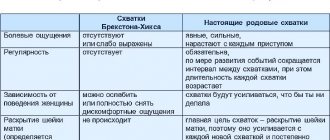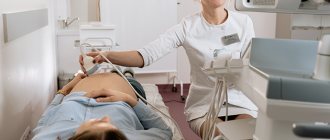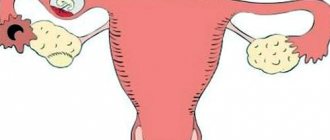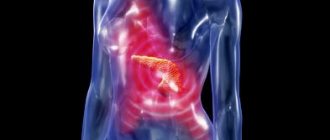IVF is a technique that allows a large number of infertile couples to successfully conceive and bear a child, even in cases where infertility was considered incurable.
IVF (in vitro fertilization) is a method that allows you to fertilize an egg (female reproductive cell) with a sperm outside the female body and, after a few days, implant the fertilized zygote into the uterus. IVF is also called “artificial insemination” or “in vitro fertilization”.
In some cases, patients report pain after IVF. Most often, they are associated with the procedure itself, which involves a certain intervention in the body, and go away on their own, without requiring treatment. But you shouldn’t ignore the pain and attribute it to IVF; you should definitely visit a specialist.
Reasons for prescribing IVF procedure
Like any other medical procedure, IVF requires certain special preparation and a preliminary full examination of the woman and her partner. This allows the doctor to get a complete picture of the patient’s health, determine the main cause of infertility, decide whether IVF is mandatory, or whether conservative treatment (medication) or simpler methods, such as insemination, can be used. It is necessary to understand that in vitro fertilization is prescribed when other treatment methods are ineffective. In addition, the IVF procedure is quite expensive.
Diagnosis of pregnancy using ultrasound
During ultrasound diagnostics, the doctor takes into account the results of hCG tests. Ultrasound can detect a fertilized egg only when the hormone level is 2000 mU/ml of blood plasma, which corresponds to 21-22 days of pregnancy. At this stage, ultrasound is an extremely important measure to detect multiple pregnancies or ectopic ones. For an accurate diagnosis, it is necessary to use a test for hCG in blood plasma in combination with ultrasound.
We should not forget that the onset of pregnancy within the framework of an IVF program depends not only on the individual characteristics of the potential mother’s body, but also on the qualifications of doctors, as well as the quality of the clinic’s equipment. Doctors at the IVF Center clinic in Orel will examine the couple, select an IVF program individually, give recommendations on how to normalize sensations after embryo transfer, and monitor the development of pregnancy. We will definitely help you overcome infertility and become parents!
Pain after IVF: OHSS
As it became clear from the above, the IVF procedure is not a simple one and requires quite serious intervention, first of all, in the woman’s body.
At the first stage - preparation for in vitro fertilization - an examination is carried out, which does not cause much discomfort to the woman. But the second stage - the collection of female reproductive cells (eggs) involves active intervention in the female body, which disrupts its usual functioning.
It is necessary to understand that normally, in a woman’s ovaries, one egg matures almost every month, ready for fertilization (ovulation). To carry out the IVF procedure, it is necessary to obtain several eggs. For this purpose, the patient is prescribed medications (hormone injections) that stimulate superovulation (the maturation of several eggs). Making such preparations for material collection may be the reason that the patient will experience pain after IVF. But this is not at all necessary.
There is such a complication of IVF as ovarian hyperstimulation syndrome (OHSS). It occurs when the dose of hormones was incorrectly selected for a woman. As a result of this oversight, too many follicles (more than 15) mature in the ovaries. This entails a number of undesirable consequences, as the follicles begin to produce excess amounts of estrogen.
There are three degrees of severity of ovarian hyperstimulation syndrome: mild, which occurs in almost 30% of all IVF procedures performed, moderate and severe. The last, severe degree of OHSS is a rather rare phenomenon and does not exceed 1 - 2%.
Mild OHSS does not require special treatment; the patient is only advised to adhere to a certain regimen and drink plenty of fluids. If your stomach hurts after IVF due to mild OHSS, you just need to wait a little and the pain will go away on its own.
Correct behavior before embryo transfer
Embryo transfer is the final and most important part of the IVF protocol, requiring proper preparation of the patient and high skill of the attending physician. Before the transfer, the patient should avoid physical activity, prefer foods that do not cause gas formation, and follow the instructions of the attending physician (usually progesterone, folic acid, and some individually selected medications are prescribed).
In the process of monitoring the development of the embryo, the attending physician is in constant contact with the embryologist and the future parents, discussing with them the prospects of transfer on a daily basis. Depending on the number of embryos and their quality, the transfer is carried out either on the third or fifth day of embryo life. If there are few embryos or they develop with a delay, a decision is made to transfer on the 3rd day, and it is preferable to transfer 2 embryos at once. If the quantity and quality of embryos allows, they continue to be observed until the 5th day, until the formation of the so-called. blastocysts. The procedure is performed with a full bladder. The most important thing is a positive attitude, trust in your doctor and clinic, maximum peace of mind and confidence in success!
Embryo transfer during IVF
– a technically complex procedure. In our clinic, it is carried out with constant ultrasound control, and both the doctor and the expectant mother can see on the screen everything that happens in the uterus, right down to the place where the embryo is placed. The transfer is carried out using an ultra-thin catheter with a special coating that does not damage the embryo. The entire procedure usually lasts no more than 5 minutes and is absolutely painless. The “gold standard” is the transfer of one healthy embryo to prevent multiple pregnancies, which is considered a complication of IVF. The option of twin pregnancy must be discussed with patients before the transfer, regardless of how many embryos are transferred, because Even with the transfer of one embryo, twins are possible.
Can there be negative consequences of follicular puncture?
Follicle puncture is performed under ultrasound guidance. Therefore, complications are rare. However, sometimes this can happen.
- Formation of a hematoma in the ovary or intra-abdominal bleeding. Such consequences may be due to the individual characteristics of the course of blood vessels, as well as their significant size.
- Attachment of infection. This complication can occur in women with weak immune systems. To minimize risks, the procedure is performed when the vagina is in normal biocenosis (first or second degree of smear purity).
Features of in vitro fertilization
In vitro fertilization is a modern reproductive technology that is used for infertility. During the procedure, an oocyte is removed from the ovaries and fertilized under “in vitro” conditions. After this, the diploid cell is cultivated in a special incubator for 3-5 days.
The reproductive specialist decides at what point to transfer the embryo into the uterus, focusing on the degree of preparedness of the endometrium for implantation. It is believed that five-day-old embryos take root better, but not all fertilized oocytes can survive to transfer at the appointed time.
Risk factors contributing to the development of complications
When undergoing IVF, 5-6% of women experience negative consequences.
The main causes of complications are:
- ovarian puncture;
- chronic inflammatory processes of the reproductive system organs;
- endometriosis;
- adhesive disease;
- benign and malignant tumors.
Puncture during IVF is the most common cause of bleeding. Blood loss can develop before puncture, during or immediately after the procedure. There is also a group of late bleeding that occurs 6-12 hours after manipulation. The development of a pathological condition is indicated by increased heart rate, pressing pain in the perineum, a feeling of pressure on the rectum, enlargement of the abdomen, and its soreness. Since blood loss can become critical, all patients after puncture should be under the supervision of medical personnel.
- Chronic inflammatory processes in the pelvic organs after IVF may worsen. This leads to various complications of pregnancy, including infection of the fetus. Women with inflammatory diseases should take medications, and taking even the safest medications while pregnant is completely useless.
- Endometriosis is a pathological condition (read more here) characterized by the presence of foci of endometrioid tissue outside the uterine cavity (external endometriosis) or excessive growth of the uterine mucosa (internal endometriosis). Usually, the condition of patients with endometriosis improves during pregnancy, as a result of changes in hormonal levels. But sometimes, after IVF or a normal pregnancy, the condition can worsen, interfering with the normal growth and development of the fetus, disrupting the functioning of the amniotic structures.
- Adhesive disease can contribute to the development of ectopic pregnancy during IVF, so all adhesions must be removed surgically and conservatively before entering into the protocol.
- Benign tumors deform the uterine cavity, making bearing a baby after IVF impossible. Malignant neoplasms pose a direct threat to the life of a woman and child, since against the background of a physiological decrease in the immunity of a pregnant woman, tumor growth may accelerate.
Advantages of treatment at the SM-Clinic reproductive health center
Reproductive Health Center "SM-Clinic" uses assisted reproduction methods in accordance with international protocols based on evidence-based medicine. Our specialists regularly improve their professionalism at the best clinics in the field of human reproduction. We have installed modern equipment that allows us to monitor folliculogenesis and changes in the endometrium down to the smallest detail. All these circumstances are the key to the safety and high effectiveness of the treatment methods used.
Doctors at the SM-Clinic reproductive health center will help you become parents without risk to your health. We provide assistance at all stages of infertility treatment.
What not to do
After completing the IVF procedure and the start of gestation, a woman needs to be very careful. She must give up many familiar things.
You should avoid visiting places where large numbers of people gather. In this case, she is at risk of contracting infectious and viral diseases, which can cause irreparable damage to the developing embryo.
Sexual activity is prohibited during the first 5 days after IVF. Intimacy can cause increased pain and increases the risk of rejection of implanted embryos.
You need to reconsider your usual diet. You should strictly monitor your diet, including only healthy foods in the menu. Otherwise, you may experience disruption of the gastrointestinal tract - constipation, increased gas formation - and the development of an allergic response.
It is strictly forbidden to visit baths and saunas. Hot air and water can provoke a significant deterioration in overall health, increased bleeding and the development of miscarriage.
Alcohol and smoking are prohibited. They can also cause disruption of the functioning of the gastrointestinal tract and increased pain. In addition, harmful substances negatively affect the development of the embryo.
Significant physical activity can provoke a deterioration in well-being. The woman's pain increases. There is a high risk of embryo rejection.
Stressful situations must be avoided. To relieve nervous tension, you can take natural sedatives. The use of medications obtained by chemical means is prohibited.
Increased uterine tone
Hypertonicity is contraction of the uterus before the expected day of birth. Often occurs in the early stages or after embryo transfer. Diagnosis is needed, because in the future this condition can become a threat to the normal gestation of the fetus.
There are two types of hypertonicity:
- diagnosed only by ultrasound;
- felt by a woman.
Do not panic ahead of time, because such symptoms could arise against the background of temporary factors. It is very important to ensure peace and sit less.
How to distinguish implantation bleeding from menstruation?
Light discharge associated with embryo implantation does not contain clots. They are usually pink or brown in color and last for a maximum of 3 days. With implantation discharge, the lower abdomen does not hurt, as during menstruation. In addition, much less blood is released.
Embryo implantation may cause slight bleeding. This usually does not indicate any problems, but is a normal symptom of early pregnancy, occurring in approximately 15-25% of women.
HCG analysis - rules for delivery
The concentration of hormones in the body of the expectant mother is determined by collecting venous blood. Reproductologists recommend taking tests in the morning on an empty stomach - at least 8-9 hours should pass between the last meal and blood donation. If a woman is taking over-the-counter medications, she should tell her doctor a few days before the tests.
Enzyme immunoassay must be performed not only to determine gestation. The hCG test should also be taken in the 2nd trimester of pregnancy in order to identify defects in the development of the child. Correction of maintenance therapy can prevent up to 25% of congenital pathologies and anomalies.
Doctor's opinion
Before IVF, a woman is prescribed hormonal therapy, and there are major disadvantages associated with it.
Due to increased hormonal load, disruptions in the functioning of the thyroid gland and complaints from the cardiovascular system are possible. It is widely believed that taking medications to stimulate superovulation during IVF increases the likelihood of ovarian cancer. In fact, the results of clinical studies have not established a connection between these two processes. That is, the information is unreliable. — Malakhova Victoria Yuryevna Reproductologist, obstetrician-gynecologist
Risk factors for OHSS











